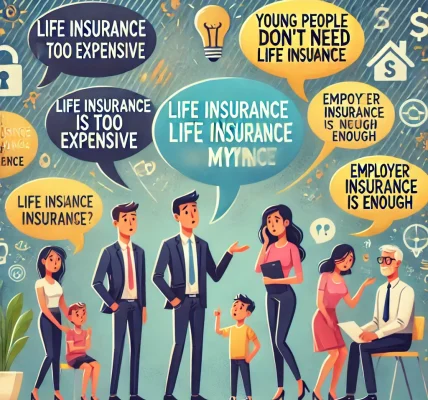Introduction
Every parent dreams of providing their child with a quality education, but rising tuition costs can make it challenging. Many families struggle to save enough money to cover these expenses, leaving students burdened with loans. However, an often-overlooked financial tool—life insurance—can help secure your child’s educational future.
Life insurance is not just a safety net for your family in the event of your passing; it can also be used strategically to fund your child’s education. This guide explores how you can leverage different types of life insurance policies to build an education fund, along with the pros, cons, and steps to get started.
1. How Life Insurance Works as an Education Funding Tool
Life insurance provides financial protection by paying a death benefit to beneficiaries upon the policyholder’s passing. However, certain policies also offer a cash value component that can be used for various financial goals, including education expenses.
Here’s how life insurance can help:
- Cash Value Accumulation: Whole life and universal life insurance policies build cash value over time, which can be accessed for educational expenses.
- Tax-Advantaged Savings: The growth in the cash value component is tax-deferred, meaning you won’t pay taxes on it as it grows.
- Guaranteed Payout: In case of the policyholder’s untimely demise, the death benefit ensures your child’s education is financially covered.
- Loan or Withdrawal Options: Some policies allow you to borrow or withdraw from the accumulated cash value without affecting the death benefit significantly.
2. Types of Life Insurance for Education Funding
2.1. Whole Life Insurance
Whole life insurance offers lifetime coverage with a built-in cash value component that grows at a guaranteed rate.
- Pros:
- Guaranteed cash value growth
- Fixed premiums
- Can be used as collateral for loans
- Cons:
- More expensive than term life insurance
- Slower cash accumulation in the early years
2.2. Universal Life Insurance
Universal life insurance provides flexible premiums and a cash value that grows based on market interest rates.
- Pros:
- Flexibility in premium payments
- Potential for higher cash value growth
- Can be adjusted to fit financial goals
- Cons:
- Cash value is subject to market fluctuations
- Complex to manage compared to whole life insurance
2.3. Term Life Insurance (As a Backup Plan)
Term life insurance does not build cash value, but it provides an affordable way to ensure that if something happens to you, your child’s education costs will be covered through the death benefit.
- Pros:
- Lower premiums than whole or universal life
- High coverage amounts
- Simple to understand and purchase
- Cons:
- No cash value accumulation
- Coverage ends after the term period
3. How to Use Life Insurance for Education Expenses
Step 1: Choose the Right Policy
- If you want cash accumulation, opt for whole or universal life insurance.
- If affordability is a priority, consider term life insurance with a plan to convert it later.
Step 2: Start Early
- The earlier you start, the more time your policy has to build cash value.
- A policy taken out when your child is young will maximize benefits.
Step 3: Leverage Cash Value for Education
- Withdraw Funds: You can withdraw part of the cash value to pay for tuition or related expenses.
- Take a Loan Against the Policy: Borrowing against your policy’s cash value can be a tax-efficient way to fund education.
- Use as a Collateral for Education Loans: Some lenders accept cash value as security for student loans.
Step 4: Plan for Repayment (If Borrowing)
- If you take out a loan against your policy, make sure to repay it to avoid reducing the death benefit.
- If structured correctly, borrowing from your life insurance can be more flexible than taking out federal student loans.
4. Pros and Cons of Using Life Insurance for Education
✅ Pros
✔ Tax-Deferred Growth: The cash value grows tax-free, providing better returns. ✔ No Restrictions on Usage: Unlike 529 savings plans, you can use the funds for non-educational expenses if needed. ✔ Guaranteed Protection: If something happens to you, the policy ensures that your child’s education is covered. ✔ Avoid Student Loan Debt: Provides an alternative to traditional student loans, reducing future debt burdens.
❌ Cons
❌ Higher Costs: Permanent life insurance policies are more expensive than term policies. ❌ Limited Growth Rate: Compared to traditional investment vehicles like stocks, cash value accumulation may be slower. ❌ Potential Impact on Death Benefit: Withdrawals or loans may reduce the payout available to beneficiaries.
5. FAQs About Life Insurance for Education Funding
Q1: Can I Use Term Life Insurance to Fund My Child’s Education?
Term life insurance itself does not accumulate cash value, but if you pass away during the term, the death benefit can be used to cover education costs.
Q2: Are Life Insurance Withdrawals for Education Taxable?
Withdrawals up to the amount of premiums paid are not taxable, but loans exceeding this amount may be taxable.
Q3: How Much Life Insurance Do I Need to Cover Education Costs?
Calculate future tuition expenses and factor in inflation. A policy with at least $250,000 – $500,000 coverage is recommended.
Q4: Can I Transfer My Life Insurance Policy to My Child?
Some policies allow ownership transfer, letting your child continue the policy or use it for future expenses.
Q5: Is Life Insurance a Better Alternative to a 529 Plan?
Life insurance offers more flexibility in fund usage, but a 529 plan may provide higher tax advantages for education-specific savings.
Conclusion: Should You Use Life Insurance for Education Funding?
Life insurance can be a powerful financial tool for funding your child’s education, especially if you choose a permanent policy that accumulates cash value. While it may not replace traditional education savings plans, it provides an additional layer of financial security and flexibility.
Final Recommendation:
🔹 If you want flexible, long-term savings, whole or universal life insurance can be a great option. 🔹 If affordability is a concern, term life insurance ensures coverage in case of an emergency. 🔹 Consider combining life insurance with other savings tools like 529 plans or custodial accounts for a comprehensive strategy.
Take Action Today!
✅ Compare life insurance policies to find the best option for education funding.
✅ Get a personalized quote to see how much you need to save.
✅ Start planning early to give your child the gift of education without financial stress.



